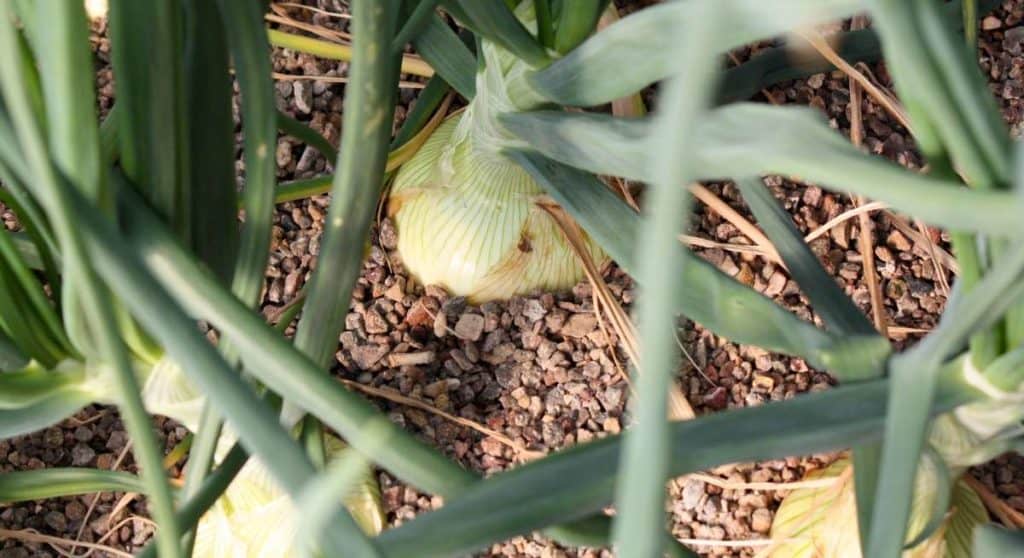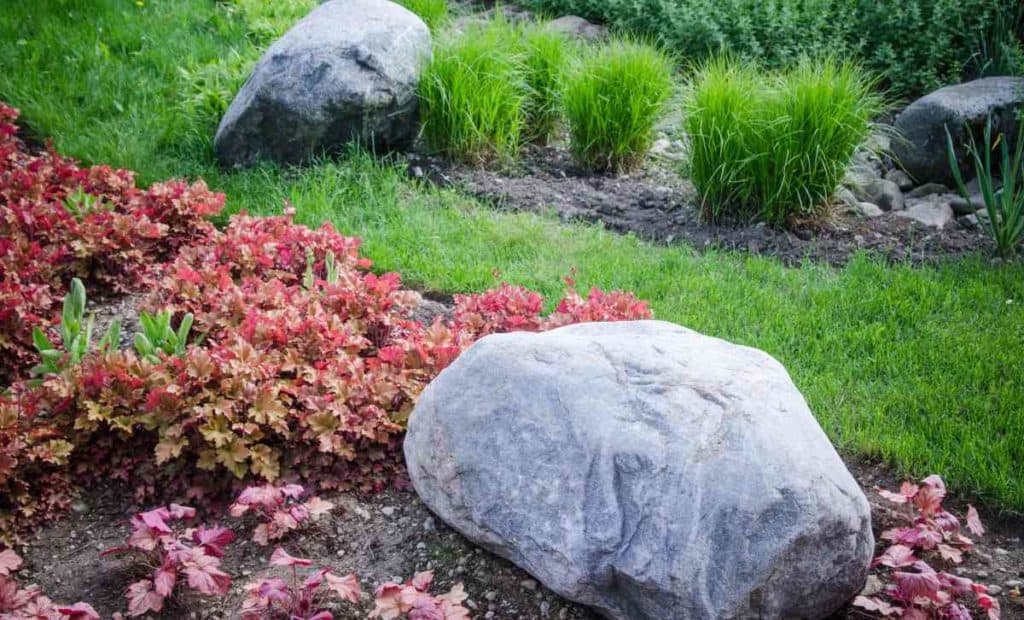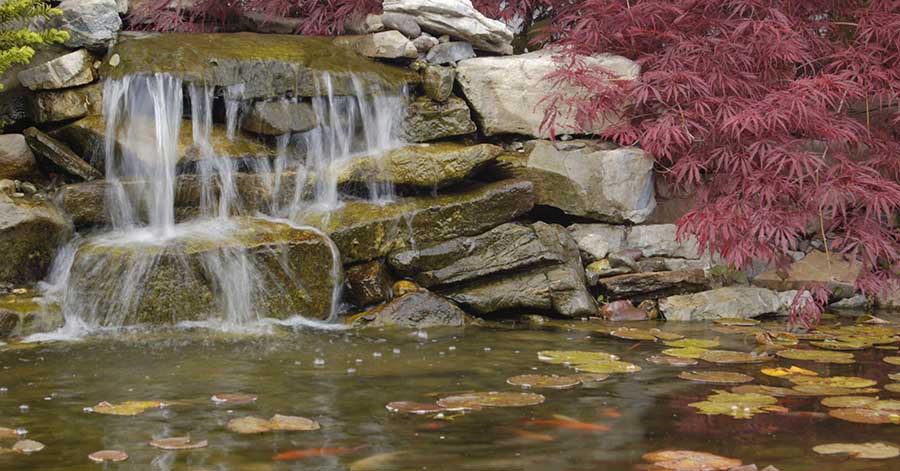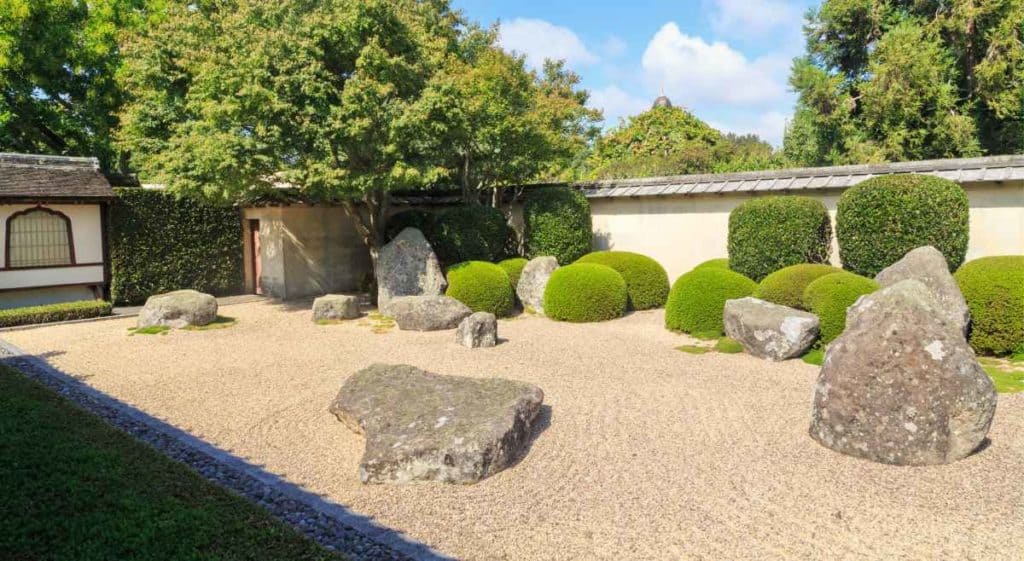There are likely as many ways to use rocks in your landscaping project as there are landscaping projects. Usually, with something like this, someone might say, “You’re only limited by your imagination!” That isn’t always true, but since there are more types of rocks out there than you could ever possibly make use of, you really do have nearly infinite options.
Here’s how to choose the right rock from your landscaping project:
- Assess the terrain size.
- Consider the area’s surroundings.
- Determine the function of the rocks you’ll use.
- Choose your rocks based on function, color, and size.
We’ll look at some of the more common rocks used in landscaping projects and what makes different stones suitable for various projects.
1. Assess The Terrain Size
You’ll want to take this into consideration for the sake of scale. If you have a small spot you’re working on– say, three feet by four feet– and you choose boulders that are a foot wide, they’ll look out of place, and you’ll only have room for a few of them and not much else.
The chances are good that you’ve done this already as you’ve looked out on your lawn and thought, “I bet I could put in a walkway there and a big waterfall over there.” But if you haven’t, this is step one. After all, you don’t go buy a bunch of wood before you decide how big the bookcase you’re going to build will be.
2. Consider the Area’s Surroundings
This is another contextual decision. If the area in which you’re working is all undulating hills and soft lines, dropping some squared-off rocks in the middle of it might be a bit jarring. There’s a bit of the artistic eye needed for this, but taking the time to think about how things will look before you start hauling in truckloads of rocks will make life a bit easier.
Also, the landscape site may have preexisting rocks that perhaps are too big to move or that you simply want to keep because you like the way they already look. If you have a row of sandstone rocks, augmenting it with lava rocks may not be the best look. This is along the lines of working with what you have.
3. Determine the Function of the Rocks You’ll Use
We’ll talk about some ways to use rocks in your landscape project (find out how to get rocks for free) when we talk about specific kidneys of rocks, but let’s start with a look at some rock options and how to tackle them so that you and your family are happy with the results.
Using Rocks as Mulch
Buying cedar mulch (or any organic mulch) and spreading it throughout your garden is an annual undertaking. Since it’s organic, mulch breaks down with time, weather, and sunlight. It’s also easily washed away in a gully-washer, so you’ve got to replace it at least once a year, more if you get lots of rain where you live.
Using pea gravel as mulch is an option that you’ll only have to do once. Sure, you might lose a little in a hard rain, but great gouts won’t be washed out of your garden. Rock mulch is a more permanent solution to your mulching needs, and it’s a little out of the ordinary, so it can lend a nice pop to your garden.
The downsides here are twofold: rock mulch will not provide any fertilizer the way organic mulch will, as rock mulch doesn’t decompose. There is also the heat problem. If you live in a hot area, the pebbles in your rock mulch will hold a lot of heat and can burn up your plants. Rock mulch is not a good choice if you are gardening in Tucson, but a Boise, Idaho garden would love some of this stuff.

Pavers as Walkways
If you want to have a pathway other than the concrete sidewalk, the city poured long ago when your neighborhood was getting built, using rocks for making walking paths is a great option. Like anything else involving rocks in your landscaping projects, the possibilities are endless.
Before choosing the rocks and building your walkway, think about the purpose of your walkway. Walkways can keep people off the grass and soil, but they can also work as a design feature. Maybe you want to build a serpentine path that will allow you to walk a circuit through your entire garden.
Think also about who will be walking the path. If you anticipate more than one person at a time, you’ll want a walkway at least three feet wide to allow two people to walk abreast through the space.
Before you lay the first stone, though, you’ll want to put down some ECOgardener Landscape Fabric on Amazon.com. Doing so will help keep weeds at bay and is a better option than rolling out some plastic over the dirt and hoping for the best. Landscape fabric allows water and air to move freely into the soil below, which will keep your soil viable. After all, if you decide later to do something else with that walkway path, you’ll want the earth to support plants.
Cobblestone Walkways
Technically, a cobblestone is a rock that’s bigger than a pebble but smaller than a boulder. That leaves a lot of room, sure, but almost everyone has seen some sort of cobblestone walkway or street. Smooth, rounded sedimentary rocks get laid out over the preferred pathway. Since the stones are often big enough to allow us to step on just one at a time, cobblestones make for a smoother walking surface than river rocks.
Another use for cobblestones (and larger rocks) is to assist with crowd flow. Placing large rocks in areas where you don’t want people walking is a more elegant solution than posting a sign that says, “Don’t stop here.”
Flagstone Walkways
Mentioned above for use as stepping stones—perhaps three flagstones spaced in your butterfly garden to allow you to walk through it without disturbing the plants and soil—flagstones can make an entire walkway, as well.
When using them as pavers, again, you’ll want to piece them together to allow for the smallest gaps between them while making the whole collection of flagstones form the larger shape of your patio or walkway.
Mortar for Walkways
Cobblestones and flagstones (when used as pavers) need mortar to bind them together. Now, you don’t need actual mortar like you’d use between bricks because these rocked areas aren’t supporting any kind of structure. However, if you just put the rocks down, you’re going to get weeds and grasses growing up through the gaps.
Filling these voids with pea gravel is an option. However, Buddingco Polymeric Sand on Amazon.com will better fill the gaps, and an even better filler that also offers a more permanent solution is Quikrete Mortar Mix on Amazon.com. Another alternative, especially with flagstones, is to create a pathway with gravel, then place the flagstones down in it, spaced as stepping stones. This is a unique look that will give your landscape project a sleek, modern feel.
Finally, one school of thought aims to involve the senses in whatever pathway you’re building. This involves planting aromatic plants between the stones, such as small mint plants, so that when you walk on the path, you release a lovely aroma as you step on the mint. Just a thought.
Accents and Edging
If you’re looking for rocks for your landscaping project, the chances are that you’re looking for more than just stuff to step on. Using larger rocks as accents is a popular and relatively easy way to add color and height to your project. A lighter-colored boulder sitting among your dark green plants or black soil makes a nice visual.

Be careful here, though, as you want to place the rocks just right. Specifically, if you have a rectangular rock, don’t stand it up on its end lest you look like you have a cemetery in your front yard. Great for Halloween, sure, but that’s one day out of 365.
You may also want to set off certain areas with rocks by making an edge with them. Many gardens get set apart from regular old lawns by a rock border. This involves a lot of digging, sure, but it yields a really nice look with a clean edge around your garden’s soil.
Space them as closely together as possible to discourage grass from insinuating itself among your zinnias (especially St. Augustine grass, which seems to seek out only places you don’t want it to grow).
If you’re making an edge with rocks, you may also want to consider something like Benda Board Garden Planter and Pathway Bender on Amazon.com, which is landscape edging you can put between your rock border and the garden to help discourage grass and weeds from growing through the rocks.
There’s also the option of using fake rocks that serve the same purpose as landscape edging. Suncast’s No-Dig Landscape Edging on Amazon.com offers a strip of faux rock with an edge coming off of it that you can push into the ground—by hand in softer soil. This eliminates digging, which is a plus to people who are going for quick-and-easy.
Creating Levels with Rocks
Larger boulders can create levels in your project. This is especially handy if you’re building something like a large water feature. Place the larger boulders on top of one another to build up a nice, tall place for your waterfall to cascade over.

Aside from a water feature, you can use boulders as a sculptural element to your garden or project or build several levels of lawn or garden. A large rock in your garden can also help hold moisture in the soil. Think how many times you’ve turned over a big rock on a hot, dry day and found mud and bugs under there. Putting a few large rocks in your garden will help keep some water in place.
Rock Gardens
A rock garden can be a lovely addition to—or even a substitute for—your lawn. Drought-prone areas are perfect for a rock garden since there’s so much less watering involved than with a yard full of Kentucky bluegrass.
Use large boulders to build a retaining wall at the rear of your rock garden so that you’re making the back wall of it. This will give your rock garden a slope. You can then use smaller rocks to create some topography, perhaps even creating the appearance of different strata or even a crumbling ruins look, then add your soil. Incidentally, the more rocks you use, the less dirt you’ll need.
You will need at least some soil, though, because rock gardens aren’t just rocks. The garden part means growing things, and most rock gardens usually consist of plants, shrubs, and even trees that generally don’t grow more than a foot (30.48 cm) tall. You wouldn’t want to plant a large pine tree, as its root system would eventually ruin your structure, and your retaining wall and rock garden probably won’t hold a large tree in place for very long, anyway.
The placement of the rocks in your rock garden should be the fun part, as it’s the artistic element of the entire process. Placing the rocks, boulders, and plants in a manner most pleasing to you should be your biggest concern here. Also, don’t overplant. Since it’s a rock garden, seeing the rocks is part of it.
If you’re going for the no-grass, completely rock lawn, you’ll want to use gravel or river rock in place of the vast green expanse of grass, then use other rocks in various sizes for accents. Remember to plan for some plants, too. Even in a rock lawn, you don’t want just rocks, even if you have lots of different colors for accent. Putting some smaller plants here and there will soften the look.
A full rock lawn will suck up some heat, so it’s not a viable choice if you have kids who want to play in the front yard during the hottest part of a summer day.

4. Choose Your Rocks Based on Function, Color, and Size
From a grain of sand (which is literally a tiny rock) to a two-ton boulder, we have so many options for our yards, and that’s just the size. The relatively light and porous lava rock presents color and texture options for your garden, and we get denser and heavier rocks all the way up to granite boulders and the like.
Each has a purpose, and we choose stones based on their appearance and function.
Crushed Granite
Crushed granite is the closest in consistency to sand. It’s often used as a ground cover, such as around trees (since your leafier trees may cast too much shade to allow for good grass growth), and can also serve well as the surface of a walking path.
And because granite isn’t just one color, you have some flexibility there. This is also a good choice for use as a kind of “mortar” around larger stones, which we’ll discuss more in-depth in a bit.
Pea Gravel
Another good choice for a garden path, pea gravel consists of individual pebbles not more than 1/4-inch in diameter and offers some color variations. Past form, pea gravel can bring some function with it, as pea gravel makes a good substitute for mulch. Pea gravel also drains well, suppresses weeds, and is resistant to rodents.
Lava Rock
It’s available in many colors so that it can serve well as accents in your landscape project. Because it forms from cooling lava, which bubbles, lava rock is shot through with many tiny holes. These make for the lightest kind of rock, but all those holes also make for more total surface area per rock.
This matters because more surface area means the rocks can absorb more heat. If you live in a hotter area, this can help your plants through those brutally hot days. Then at night, the heat gets released.
The multiple available colors make lava rocks a good choice for accents, and the varied sizes allow for use as ground cover, too, so lava rock is a form-and-function choice for your garden.
River Rock
Consisting of smooth, rounded pebbles, individual river rocks are usually no bigger than two inches wide. While it’s smooth, river rock is a little too big to make for comfortable walking, so this isn’t the best choice for garden paths. Still, it’s perhaps the most commonly used rock in landscaping.
However, as an accent, perhaps around a specific garden feature or even another rock, it’s a great choice. Landscapers tend to love the versatility river rock’s different colors can bring to a project.
Flagstones
These are flat, sedimentary rocks most often used as pavers and stepping stones. Generally ranging from 1/2 to 3 inches in thickness, flagstones come in all shapes and sizes. When you’re making a walkway or patio with them, there’s a jigsaw-puzzle aspect to the project as you fit the rocks of different sizes together.
If that’s not your jam, there are molds out there for making your own. CJGQ’s Walk Maker Concrete Path, available on Amazon.com, allows you to pour concrete into the mold to create a flagstone look without having to figure out how to fit everything together.
And for stepping stones, there are endless varieties of rocks, including manufactured options for showing Team Sports America NCAA Garden Paver Logo Stepping Stone and DIY projects like the Klever Kits Store Mold Your Own Stepping Stones Kit on Amazon.com your kids can work on. Every time you walk through your garden, you can look down and remember back when your kid was cute and made this adorable flagstone before he became a surly teenager.
Boulders
Technically, a boulder is a rock that’s more than 10.1″ in diameter, so if you drive a Prius, you’ll need these delivered. While ten inches isn’t an enormous rock, boulders can start to get pretty heavy quickly depending on the kind of rock they are.
You can find them in all sizes. Boulders are big enough that at a certain point, rock vendors begin classifying their size by using the term “man.” Like, “This is a 5-man rock.” Five times the size of a man. That’s a big rock.
These are for accents, building retaining walls, adding layers into your landscape, and building furniture. Again, they’re heavy and unwieldy, so know exactly where you want your boulders. Once they’re unloaded and set into place, you don’t want to have to move them.
Boulders also often bring moss and lichens to your garden. These organisms can bring texture and colors to your garden you wouldn’t otherwise have.
There are so many other types of rock, some a little more specialized than others, but these are some of the main choices used most often.
Key Takeaways
When trying to choose the right rock from your landscaping project, first assess the terrain size and consider the area’s surroundings. Once you’ve determined the function of the rocks you’ll use, choose your rock size accordingly. This will ensure you get the right size for any purpose!
Sources
- Backyard Boss: How to Build Rock Gardens: Everything You Need to Know
- Colorado State University: Ground Covers and Rock Garden Plants for Mountain Communities
- Earth Development Inc.: How To Pick The Right Landscaping Rock For Your Home
- Ephenry: When to use stones or mulch in your landscape
- Grabco: How To Enhance Your Garden With Gravel
- Hunker: How to Lay Cobblestones With Mortar
- Minick Materials: A guide to choosing landscaping rock?
- Oklahoma State University: Rock Gardening in Oklahoma
- Own the Yard: What To Put Under Rocks to Prevent Weeds from Growing 2021
- Stoeckig Landscape Group: How to Choose the Right Rock for Your Landscape
- University of Florida: Using Rocks in the Landscape
- University of Florida: Walkways in the Landscape
- University of Missouri: Residential Landscaping | MU Extension

